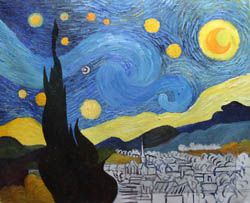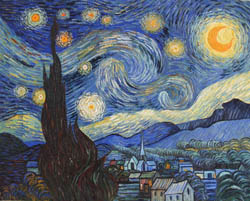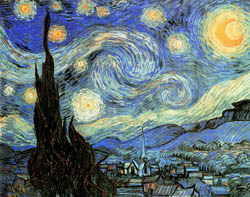|
Step 1 – Sketch on the canvas: |
|
|
Sketch is the first step of a great painting. An accurate sketch makes sure the dimensions and proportions of the reproduction are correct from the beginning. Our artists usually use a grid system to make a pencil sketch! |
|
|
Step 2 – underpainting, first layer of paints: |
|
|
Following the sketch, the first coat or "under painting" is laid down. It is normally painted with turpentine thinned paint. This layer helps to "tone" the canvas, and cover the white of the gesso. This layer can be adjusted before continuing. |
|
Step 3 – Build up the forms of objects: |
|
|
After the first coat dries, the artist then proceeds to paint a "mosaic" of color swathes, working from darkest to lightest. The borders of the colors are blended together when the "mosaic" is completed. This layer is then left to dry before applying details. At this stage, we normally send you a "process photo." Please be prepared, because the painting at this stage is very ugly and rough. |
|
|
Step 4 – Adding details, shading, color contrast and highlights. |
|
|
This step is very important. It is now time for the artist to utilize their painting technique with different brush sizes and types. By using more or less paint on the brush and accurately adding color or highlights, the artist makes sure that the particular characteristics and unique features of the original are reproduced accurately. Once this has been completed, our master artist comes to inspect the painting and provides guidance for the painter to make |
|
Step 5 – Finishing touch! |
|
|
When the painting is finished, our quality control director will compare it with the original photo and ask the painter to make further adjustments, if necessary. Photos will then be taken and sent to our customer for approval. If the customer requests any changes, we will make those changes immediately, and then send a new photo. We ship the paintings only on receipt of our customers' approval. Customer satisfaction is 100% guaranteed. |
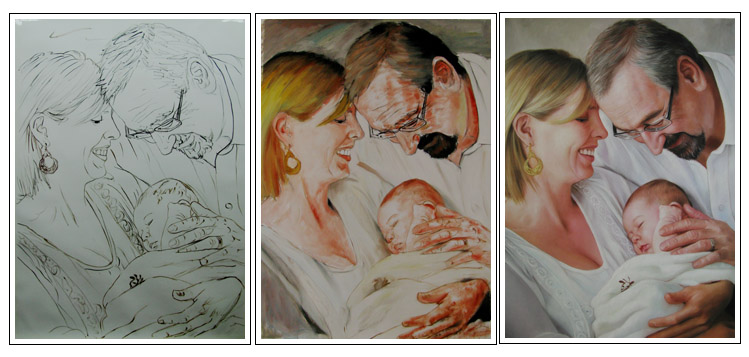
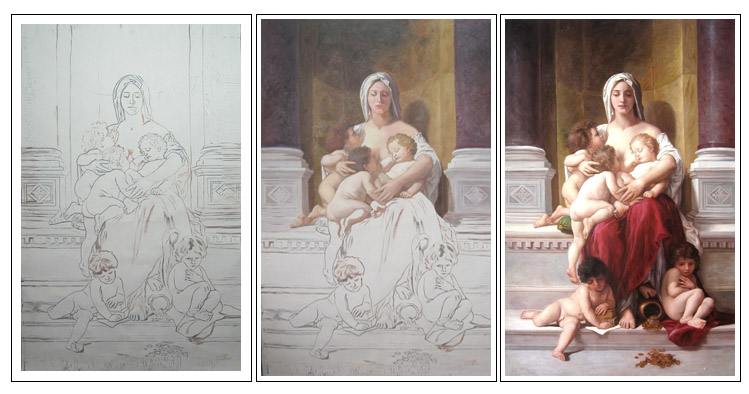
 There are many kinds of canvas on the market, but we use only three types that have given our customers the best satisfaction over the lifetime of the paintings. The first type, which we use most often, is linen canvas. Linen canvas is made of more expensive material and is more durable. It also holds colors and shadings on the painting for many years. We also use synthetic canvases which are excellent for finer works, like realistic portraits or architectural paintings. The third type of canvas we use is “cracked” canvas. This is usually requested for renaissance style paintings because it gives a more aged/antiqued effect. |
 |
 Oil paint comes in many different brands. We use Holbein DUO Oil, Van Gogh H2O, and Winsor-Newton Artisan. Oil paints also come in different grades, but we use only professional or artist grade paint. We use professional grade paint because it contains a higher grade of pigment and is chemically stable. The color lasts forever, it is environmentally friendly, and is nontoxic. |
 |
 Paint brushes are made from stiff or soft hairs, from either natural hair or synthetic fiber. In our studios, you will see countless brushes in different sizes and shapes - round, flat, bright, fan and filbert. Our artists choose the most suitable brushes for the style of the painting. A Van Gogh painting naturally requires very thick texture and therefore a flat brush with thicker bristles is required. A Michelangelo painting, on the other hand, would require using a very fine round brush and a fan blender that leaves no mark at all. |
 |



